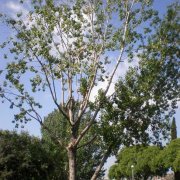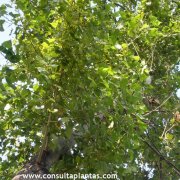Care of the tree Populus nigra or Black poplar |
|
The genus Populus, family Salicaceae, includes 40 species of trees native to cold and temperate areas of the Northern Hemisphere. Some species are: Populus nigra, Populus alba, Populus tremula, Populus mexicana, Populus tremuloides, Populus deltoides, Populus lasiocarpa. Common names: Black poplar, Lombardy poplar. This species is native to Europe, the Mediterranean region, and Central Asia. They are dioecious deciduous trees of columnar bearing that widen with age and reach 30 meters (98.4 feet) in height. The bark is gray with dark cracks. The leaves are triangular in shape, the edge is serrated and are deep green on the hay and light green on the underside. The flowers appear before the leaves and are hanging catkins that are not decorative. Black poplar is used to fix banks, next to ponds and water courses, as isolated specimens and to form rows in wet meadows. Do not plant near buildings due to its shallow roots. Populus nigra needs full sun exposure and a temperate climate with cool summers. It resists frost very well. Lombardy poplar grows in any type of soil except saline ones; it prefers deep soils with abundant organic matter. Water regularly so that the substrate is always damp. Black poplar does not resist drought. Fertilize with manure or compost in spring or fall. Prune lightly in fall to strengthen growth. Populus nigra can be attacked by fungi if too much moisture builds up on the roots and by caterpillars that devour the leaves. Black poplar is propagated from seeds sown in spring, by cuttings in winter and by separating suckers. |
Images of the tree Populus nigra or Black poplar |
Find plants
Populus nigra or Black poplar | Care and Growing
© 2025 FavThemes

